COURTESY: KiwiFlyer Magazine
Magazine of the New Zealand Aviation Community
SOURCE: Issue 20 – January / February 2012
SUBSCRIBE: http://www.kiwiflyer.co.nz/
CREDITS: Michael Norton – Editor | Publisher KiwiFlyer Magazine
EDITOR: New Zealand has a massive aviation community – many times higher per capita than many other countries. And the BEST way to follow the latest in New Zealand flight happenings is through KIWI FLYER! – subscribe now….
Flight Review
In our August issue of KiwiFlyer we profiled the new Guimbal Cabri G2 which was then due to arrive for NZ Distributors Pacific Aircraft Sales in September. Two aircraft were imported, one the first Australasian customer in Christchurch and the other as a demonstrator and for use by sister company Pacific Helicopter Training.
In December, your KiwiFlyer Editor visited Pacific Helicopter Training for a test flight and in the course of a very enjoyable summer’s day in Canterbury hosted by Director (and A-Cat Instructor) Terry Murdoch and Instructor Chris Hollands, also obtained a rating in the aircraft.
First impressions of the Cabri Helicopter
It’s difficult to approach the Cabri without some pre-conceptions, though with the aircraft still relatively new to the marker (these are serial numbers 24 and 25), there isn’t a great deal of informed commentary available to review in advance.
The company’s marketing speaks of technology and safety but how much of this would be specifications on paper and how much would come through in the feel of the aircraft and what it is like to fly? I hose who choose to be critical speak of price, though inevitably this is without ever having seen or flown one.
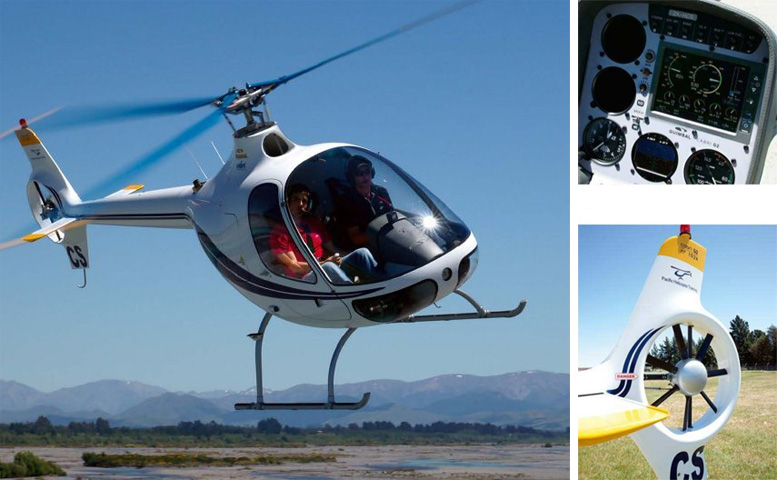
TOP RIGHT: The Electronic Pilot Monitor with automatic display of power available and throttle position, plus fuel burn and flight time remaining.
BOTTOM RIGHT: Bruno Guimbal shares the fenestron tail rotor design patents with Eurocopter.
Competing aircraft are obviously the Robinson R22 and Sikorsky (was Schweizer, was Hughes) 300. So the expectation was for a modernized cross between a 300 and a 22, priced at the top end of the two scat helicopter market.
What you get for your money though, is actually a lot more than you might expect. The Cabri Helicopter has all the essence of a small Eurocopter built to the very latest standards, perhaps creating a new market all of its own. Its not necessarily an aircraft that is directly comparable to either the R22 or the 300 at all.
Walking up to the Cabri, you’ll first notice that it is genuinely attractive and that the rotors seem low (about 13 inches less than an R22). Walking around it you’ll notice that it is exceptionally nicely built and that there has been a great amount of effort put towards attention to detail.
The impression is akin to that you get Bom closely examining a European car, versus something from well, another country Everything looks exactly right, both from an aesthetic and an engineering point of view.
An introduction to the Cabri Eurocopter Helicopter.
We started with a guided tout of the Cabris features by Terry. The composite rotor blades (which are not symmetrical in profile) look like they could have come straight out of the Eurocopter factory, so it’s not surprising to be told they are manufactured with Eurocopter processes including their patented bonding methods for the stainless steel leading edge caps.
The Spheriflex rotor head is equivalent to those on the EC120 and Super Puma which again is nor surprising given that patents for the design are held by Bruno Guimbal and Eurocopter (Guimbal has work both for and with Eurocopter) for over 20 years and received technology development contracts from them that directly supported the Cabri project itself).
Blade attachment ‘forks’ arc integrated into the blades. The system is exceptionally strong, proven when Guimbal manufactured a blade with all possible defects then deliberately impacted it until there was a large divot at the root. They then fatigue tested it for months before inspecting it for integrity – and it was fine.
They also failed a main hub and then demonstrated 200 hours of safe flight. The main rotor driveshaft is milled from a billet of stainless steel, and Terry explains that there are no cast parts anywhere on the Cabri as Guimbal was not satisfied with the ability to control quality in a casting process.
Behind hinged cowls on either side (held open by pneum-struts) is the venerable Lycoming 0-360 engine (de-rated from 180 to 145hp). It’s a stark contrast to the modern technology employed everywhere else by Guimbal, though the electrical system does exchange the magneto for an electronic ignition unit on one side.
Access is delightfully easy without any bending required and the oil filler is right there in front of you and tree of obstructions — which is just one example of how all the little niggles that R22 or S-300 pilots are familiar with have been addressed.
The cowls are latched and include a safety lock that permits safe flight if the latches have not been closed properly. Also worthy of note are the engine baffles which can be removed in half an hour if maintenance happens to be required, which is quite contrast to Robinson’s arrangement.
Also in contrast to Robinson and Sikorsky, the engine pivots to engage the clutch and the main gear box takes the belt tension, leaving the drive train in permanent alignment. The fuel bladder (designed to F1 safety standards) has a capacity of 170 liters for up to a 5 hour endurance.
A 4 into 1 free-flow tuned exhaust mat of inconel (commonly used in gas turbine blades and in formula one exhaust systems) exits through the top of the tailboom to help reduce the aircraft’s noise signature which is already very low thanks Fenestron tail rotor.
Which brings us to the tail. Guimbal shares the patent for the Fenestron system with Eurocopter, Guimbal holding rights for use on aircraft below 1200kg and Eurocopter for heavier aircraft. The Cabri’s system utilizes low cost fail safe injected plastic blades with high tensile stainless steel spars.
There are no life limits on the blades and flight has been demonstrated with one blade deliberately broken in half along its chord. Of course the shrouding of the tail rotor also provides for significant bystander safety and greatly reduces the risk of tail rotor strikes in confined areas or during misjudged approaches and landings.
The shape profile of the shroud has also been designed to avoid tail rotor vortex issues. A rubber mounted undercarriage pivots like the EC 120, intended in part to reduce the likelihood of ground resonance. As well, these two NZ aircraft are the first Cabris to be set up for hook attachment.
The doors which are held open by pneumatic struts, have positive and elegant latches and are dual pinned to ensure flush closing and a good seal. Locking is by a remote key. Access is easy and there is plenty of headroom for tall pilots wearing helmets.
Wide people are easily accommodated too, with the cabin having plenty of shoulder room (6” rider than an R22). Seats are comfortable and there are 4-point shoulder harnesses that are easily latched in one operation. Of particular note are the seats have protection, such that a 2000fpm vertical impact is deemed to be survivable.

LEFT: The two Cabris helicopters outside Pacific Aircraft Sales’ hangar at Christchurch.
MIDDLE: Spheriflex rotor head. Note the blade attachment forks integrated into the composite blades.
RIGHT: Engine access is very easy. Note the unobstructed oil filler and 4 into 1 inconel exhaust system.
Guimbal estimates that half of helicopter crash fatalities could be prevented by the crash protection features built into the Cabri. Needless to say it meets the very latest EASA safety standards.
Something else to delight R22 and S-300 pilots is the 200 liter boot (with a 40kg capacity), accessible from a panel on the right side of the fuselage and also from inside the aircraft, meaning that a camera or AIP, etc. can easily be stowed and accessed in flight. There is also a small compartment in front of the instrument console for storage of dual controls.
There is a normal suite of standard instruments, except for RPM and engine monitoring which are all cared for by the Electronic Pilot Monitor (EPM). This is a digital display panel that most interestingly also includes a Multiple Limit Indicator which combines several critical performance indicators (engine speed and power setting, fuel flow, oil temperature and ambient air pressure) into one instrument for the pilot to monitor.
Automatic calculations drive a dual indicator to show how much throttle is remaining and how much more power (in %) is available at any time. A read out of % of throttle turned on start-up is given, helping to reduce the likelihood of an over speed on start.
And the EPM also displays fuel and flight time remaining as well as carburetor temperature (which is monitored and controlled automatically). It is also a flight logger. Should the EPM fail, there is an independent backup system for rotor rpm management which consists of 3 lights to show low, normal and high speeds.
The controls are all nicely engineered and fall to hand as you would expect. A trim hat is incorporated on the cyclic. Mixture and magneto switches are located in an overhead console. Pilot side pedals have an elegant two position adjustment available. There’s also a cup or i-pod holder, an auxiliary music input and a 12V accessory outlet.
Cabri G2 Helicopter Pre-Flight
There’s nothing especially unusual or difficult about the pre-flight, though you will need a torch if you want to check the main rotor gearbox oil level. A LED such as on the
R66 wouldn’t be a bad thing here, but if the oil wasn’t in the gearbox, you would probably see it everywhere else anyway Fenestron blade pitch range and alignment is easily checked according to markings on the tail shroud.
Start-up
Start-up is a straight forward process. So straight forward in fact that if you begin with a warm engine, you can have the clutch fully engaged and be off the ground in 15 seconds. There are the normal checks for mags, carburetor heat, clutch, and rotor horn, plus observation that the backup rotor rpm warning lights operate correctly, then gauges green, caution lights off, power limit checks (displayed automatically on the MLI), and ready for take-off on what is a hot clear day in Christchurch with a about 15kts of wind on the ground.
Take-off and demonstrations
Having completed the start-up and checks together, Terry talks me through the take-off. With a few hundred hours in helicopters with rotors that turn anti-clockwise and about one in a Squirrel, I’m very conscious I’d better be adding right pedal with power and not left (the Cabri rotors turn clockwise).
The technique in the Cabri seems to be to add in the amount of pedal you might expect, and then a good inch more. We hover in relative control as I adjust to the new aircraft for the first time and Terry arranges clearance for departure.
There does seem to be a substantial pedals offset required (that said the Cabri tail has full authority in 35kts for all directions at sea level), and I’m not used to hovering right foot down but it all comes together soon enough and with clearance received, we’re off and headed in the direction of the local low flying area.
Naturally I’m being cautious and conservative but it all seems pretty effortless so far. Having descended to the river for some fun (i.e. low flying demonstrations), Terry takes over to show how “it will do just about anything you ask it to”. And it does.
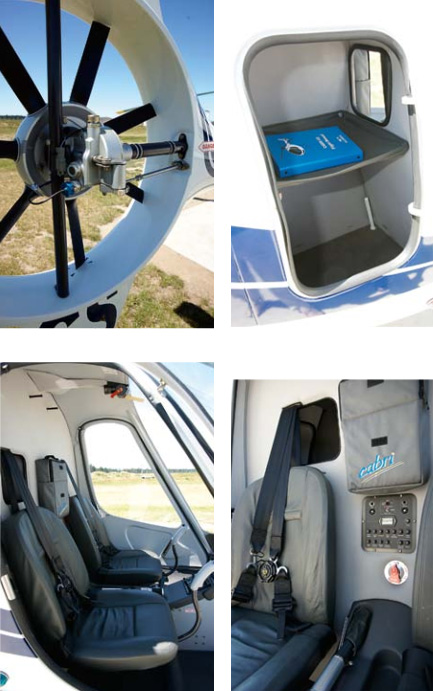
TOP LEFT: Fenestron control is by cable.
BOTTOM LEFT: 6 inches wider than an R22 helicopter.
TOP RIGHT: 200 litres of luggage space accessible from the cockpit.
BOTTOM RIGHT: 4 point harnesses connect with one easy click.
The Cabri is marvelously agile and a very great deal of fun to fly. You can flick it from one very steep bank to the other with no effort at all, climb and push over the top if you want to, and generally have a ball without feeling at all like you are approaching any limits of the aircraft.
When I take the controls back and try a range of less docile manoeuvres, the impression is very much that you can point this helicopter wherever you want it to go, and if you happen to be not all that coordinated about it, doesn’t matter – the Cabri feels very (almost disconcertingly) forgiving.
I’m used to flying R22s and S-300s with a degree of respect for the limitations of the aircraft and this is different in a way that is difficult to describe when flying the helicopter.
It feels very robust and very friendly, and not remotely like it’s just waiting for an opportunity to get the better of you, which is probably how I expected my first hour in it to be. Terry was right when he said “you’ll be confident enough to fly it home (to Ardmore) in less than an hour”.
Being able to look outside past your feet was certainly nice, something you can’t do in the R22 or S-300. Something you can do in both of those aircraft though, is open a decent vent to let some air in.
This is noticeably lacking in the Cabri except for a small vent in the door that doesn’t work especially well and it can get very hot inside if you’re in the sun without much airspeed.
This is an acknowledged problem and one that will no doubt be rectified soon (Guimbal have already supplied a door latch mechanism that allows the Cabri to be flown with doors ajar). And in the meantime, air conditioning is a purchase option.
The other possible niggle is a vibration that is predominantly prevalent on the pilot side of the aircraft at around the 85 kt mark. Time will tell if this diminishes once various systems wear themselves in, as HCS only had 50 hours on it when we flew.
Terry pointed the vibration out to me in the first place and it is easy enough (at least for R22 or S-300 pilots) to forget about if you stop thinking of it. And it might be fair to say it is more noticeable because the prior part of the flight envelope was so smooth.
The rating What better excuse to fly for a couple of hours than to get a rating. So that’s what we did (thanks Terry). Following our low level exercises in the river and that realization of just how agile and forgiving the Cabri appears to be, we headed to nearby paddocks for some out of wind slope landings.
I picked a spot and landed only to discover that the slope didn’t seem so much at all until Terry pointed out that the Cabri pivots on the rubber mounted undercarriage so that the cabin wasn’t leaning to the same degree as the skids.
Straight in and 180 degree autorotations to a power recovery required initial concentration as to which pedal was required, but were easy to execute without any drama. You do need to be quick with the yaw control on recovery though as the Cabri governor tends to snap the throttle open with a good deal of aggression — certainly more than the R22 version does.
We only had a light fuel load but the high inertia rotors and wide rotor rpm range (yellow extends from 450 to over 600rpm) meant that there were no particular requirements for careful pitch adjustments to manage the rpm throughout the descent or flare.
After some quick-stops and running take-offs/ landings Terry suggested we try hover engine off landings to which I agreed with a slight degree of discomfort — they’ve never been my favorite exercise. That said, they turned into a non-event requiring no more than correcting the yaw, letting it settle, and then adding collective to cushion the landing.
Admittedly we had some breeze in our favor but there seemed to be no chance of running out of collective to pull and it was very easy to hold the Cabri just off the ground before a gentle touchdown. We returned to the airport for lunch, then in the afternoon and now with 20+ kts of wind, we headed out again with the Cabri and an R22 for some more flying and our photo shoot.
Chris Hollands and I flew the Cabri and once at the river I got into the 22 with Terry to take pictures. It was a good contrast to experience and I still really do like the R22 a great deal, but it felt smaller, older and more vulnerable to be in, by a fair margin.
Photos taken, Chris and I flew back in the Cabri again, after a low level play and some confined area approaches. From one, Chris demonstrated a vertical climb out at 2000fpm to 1000 feet, then with the fuel countdown on the EPM showing 30 minutes remaining, we headed back to the airport.
Drawing Comparisons
If you took all the desirable characteristics of the R22 and S-300, eliminated the niggles, and then added latest technology and safety measures as well as the look and feel of a Eurocopter, then the Cabri is the result. It sits somewhere between the two in terms of size and useful load, has the spacious cabin of the 300, and exceeds the cruise performance and Vne of the 22.
Using claimed empty weight figures, the 22 offers a 519 lb usable load and the Cabri 597 lbs, meaning you can carry a good deal more fuel with you in the Cabri than the short hops that a 22 allows for with two average people on board.
The 22 however, wins the competition for IGE hover performance. With that 5191b on board, the 22 offers 9400 feet and the Cabri offers 6000 feet at ISA. At 20 degrees C, the 22 is down to 8000 and the Cabri to 5000 feet. Of course the Cabri wins massively in any comparison for technology and safety features, though these do come at a cost.
The Cabri is priced about US$100k higher than an R22 putting it at about the NZ$500k mark and pretty much on par with an R44 Raven helicopter I which of course has 4 seats and a faster cruise speed. However, Robinson helicopters require full overhauls at a very substantial cost every 2200 hours and the Cabri helicopter does not.
The Cabri in fact has no fatigue life limited components, with all components including blades and flight controls being maintained on condition. The engine and two gearboxes have 2200hr TBO lives specified and the fuel bladder has a 15 year finite life limit.
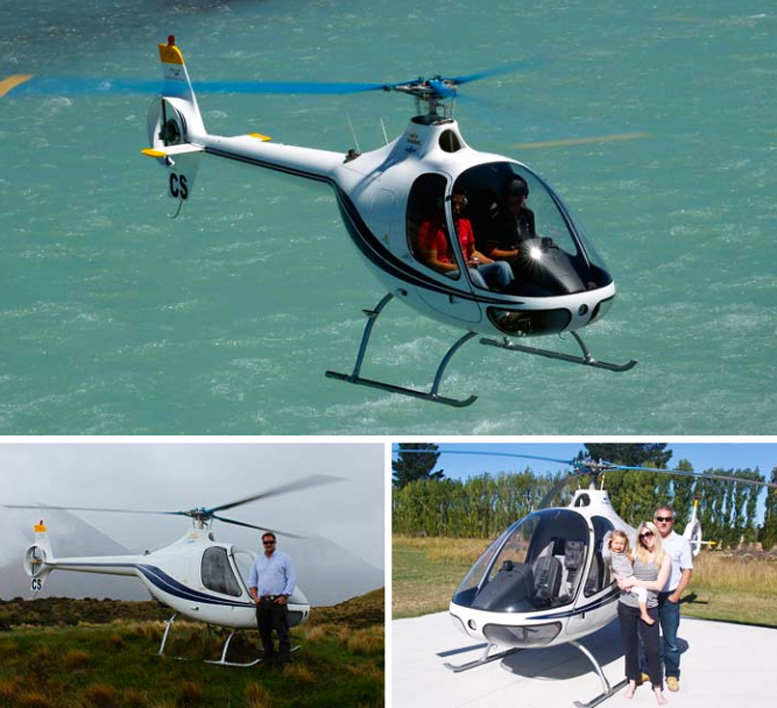
BOTTOM LEFT: Toby Wallis took the Cabri into the mountains west of Christchurch.
BOTTOM RIGHT: New Zealand’s first Cabri owner, David Cooney with his family.
Whilst that isn’t to suggest the Cabri is likely to be maintenance free, it does also mean that there is no T2 yearly’ full strip and inspection required as with Robinsons which also means that there should be negligible devaluation of the aircraft taking place as time passes, regardless of whether it is used or not.
This has to be a huge advantage for private owners who aren’t likely to fly according to the Robinson formula of 2200 hours every 12 years, diligently saving $90+ an hour to fund the pending overhaul. The disadvantage though is that there will never be ‘cheap’ Cabris on the market such as there are for entry level R22 owners buying nearly timed out machines.
Further to the R44 price comparison, if you don’t really need the extra two seats then you probably don’t want the extra fuel burn and hourly cost that the bigger aircraft requires. It all adds up to make direct comparisons difficult to construct in a meaningful way unless they are very application specific.
It’s fair to say that the Cabri isn’t likely to be produced in Robinson volumes but this is not Guimbal’s intention. Their present output is in the order of two aircraft per month with a plan to grow that to four or five per month over the next two years.
For owners who are willing to spend more to get more, who place fair value on the technology and safety that the Cabri helicopter offers, and who want to avoid a traditional maintenance cost regime, the Cabri is likely to find a new market niche all of its own.
Other Opinions
Terry gave us a list of some of the people who have flown the Cabri helicopter in New Zealand and we spoke to a few of them as well as David Cooney, who is the first Australasian purchaser. We asked each person to describe their experience in, and opinion of the aircraft and made the following notes about what they said.
Regan Graham:
Regan is a utility pilot with HeliPro and has amassed near to 6000 hours over 17 years of flying. He is rated on 12 different types from the R22 to Dauphin. He describes the Cabri as a blend of the 300’s stability and R22’s speed, with a modern feel. Regan’s first comment was that “it just seemed to want to fly”.
He says that it was very smooth and stable and that he liked the wide rpm range and ability to recover from low rpm quite easily. Regan says he thinks the aircraft is very well thought out and that it answers the need for a desirable cross between the 300 and 22 helicopters.
From a training point of view he says that “you could send students solo with a lot of confidence”, and he thinks that the Cabri is a fantastic private owners machine, particularly in regards to safety, speed and endurance.
Regan says that the controls felt very like a H500 or BK-117, that the aircraft was “very responsive” and that “wherever you point it, it goes”. He says it was very stable on slope landings and that he was having a great time in it after just half an hour at the controls.
David Cooney:
David Cooney is a PPL holder with about 200 hours in his logbook. He owned an R22 before signing up to buy one of the first two Cabri’s imported into New Zealand. David says that there were several reasons behind his purchase.
The first was to do with safety. He says he still thinks the R22 is a magnificent aircraft, but was always very conscious of his inexperience and (lack of) currency, and wondered whether, if he got behind the aircraft, he would be able to safely recover from that.
He feels better that the margins for error and recovery are much wider in the Cabri than they were in his 22 and he says that in a world where cash in the bank isn’t earning much, the decision to spend the extra money wasn’t too difficult.
David says that he takes his two and a half year old flying and feels very comfortable. He also liked the maintenance regime of the Cabri and as a private R22 owner flying a small number of hours, says he could ‘feel’ the calendar time ticking away on his 22 every time he walked past it in the hangar.
David says that the adults he has taken for a ride in the Cabri have all been very at ease whereas he used to get comments from some about the apparent smallness and perceived fragility of his R22.
We asked David why he didn’t buy an R44 Raven I instead. He says that he was happy to trade the extra two seats for the features and operating economy of the Cabri, pointing to research and his own experience of just how infrequently those extra two seats are used.
He says that 25% of the time, it would be just him and his wife going somewhere, 25% of the time he might be taking friends for ride — and they can go one at a time — and 50% of the time it would be just him in the aircraft, flying for the fun of it.
And on the rare occasion that he did need the extra seats, he was better off to hire a 44 than to operate one all the time himself. It’s hard to argue against any of those sentiments and we at KiwiFlyer congratulate David on his purchase.
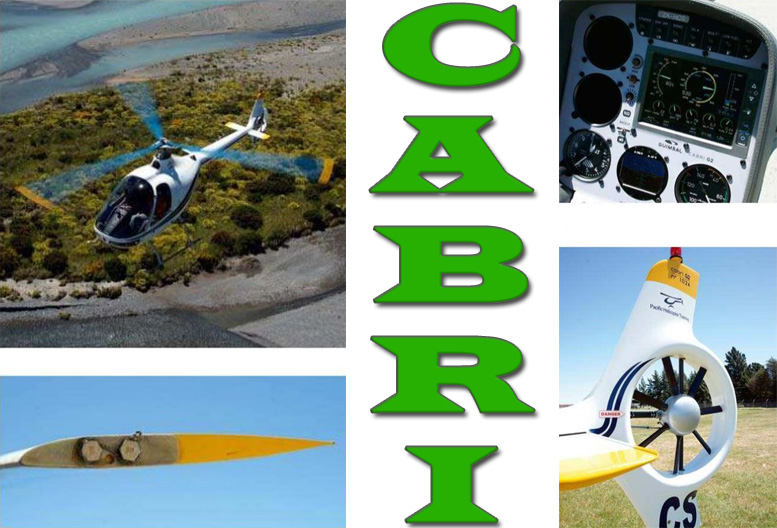
TOP LEFT: What looks right, often is, and the Cabri does.
BOTTOM LEFT: Main rotor blade profile.
TOP RIGHT: The Electronic Pilot Monitor with automatic display of power available and throttle position, plus fuel burn and flight time remaining.
BOTTOM RIGHT: Bruno Guimbal shares the fenestron tail design patents with Eurocopter.
A Sure Fire Winner – Already Knocking The Robinson R22 Out Of Contention In Europe!
EDITOR: While we may have seen a non-certifiable contender some time ago, the Aerokopter AK1 out of Eastern Europe certainly didn’t ‘take-off” with sales like we had expected. This left the door way open for an up and coming contender that could be mass produced, and type certified. Meet the worlds next best selling light helicopter (price permitting) – move over Schweizer 300 types and R22’s, here comes the CABRI!
Latest Guimbal Cabri G2 arrives in New Zealand

Frontier Helicopters’ new Cabri parked at altitude with a view of the Central North Island mountains. See the following stories for a profile on their operations.
COURTESY: KiwiFlyer Magazine
Magazine of the New Zealand Aviation Community
SOURCE: Issue 29
SUBSCRIBE: http://www.kiwiflyer.co.nz/
CREDITS: Michael Norton – Editor | Publisher KiwiFlyer Magazine
IT WAS in December of 2011 that your KiwiFlyer Editor flew one of the first Guimbal Cabri G2 Helicopters to arrive in New Zealand. Serial Numbers 24 and 25 had just been imported by Australasian Distributors Pacific Aircraft Group, one of them going to a private owner and the other as a demonstrator and part of Pacific Helicopter Training’s fleet at Christchurch.
Our review and flight test from that occasion is available for download from the KiwiFlyer website (look for Issue #20 (ABOVE)). It’s enough to simply say that we were impressed.
The helicopter takes all of the quirks of the R22 and S-300 and fixes them, with a range of significant safety features added in, very few ‘lifed’ components, elegant design features everywhere, and it has to also be said, a very attractive appearance.
Back then we reported that the factory was working on eliminating a pilot side vibration that tended to appear above 85kts (the Cabri will cruise at 100).
They were also working on a hook option for the aircraft, plus a range of other accessory items and improvements. The only niggles we could identify were that (relatively minor) vibration and that the initial purchase price was right at the top of the market, ahead of the S-300 and well ahead of an R22.
A lot of features (especially safety) were being included for that price though and when you looked at and flew the Cabri, you did feel like you were getting what you had paid for. With no requirement for 12 yearly inspections and nearly all components requiring maintenance on-condition rather than by scheduled replacement, the suggestion was that Cabri operating costs could be relatively low over the long term.
With a new design and no high-time airframes to measure by, that potential saving was still to be proven and there are no doubt a good number of operators who were waiting for a) the vibration to be improved, b) a hook and perhaps some spray gear, and c) some proven maintenance history, before being willing to take the plunge on a new aircraft such as this.
All of those items have been addressed now, with success, and we are pleased to report that two further Cabri G2s are already flying in New Zealand with more on the way. One of these new helicopters is for Frontier Helicopters based at Whakatane and the other will be operated by a large South Island station.
Point (a) was the vibration which tended to occur above 85kts. It was probably more noticeable because the rest of the flight envelope was so smooth but it was there, and it took the shine off an otherwise brilliant little helicopter.
SOLUTION: That vibration is now completely eliminated by three Vibration Absorbing Pendulums (VAPs) in the rotor head. These can also be retrofitted to earlier aircraft. The Cabri is very smooth all the way to 100kts and beyond. In short, it’s a delight to fly.
Point (b) was the hook, spray gear, and other ‘commercial’ accessories that operators who wanted to put the Cabri ‘to work’ were seeking.
SOLUTION: There is now an elegant hook installation, spray gear is under development here in New Zealand (with factory support), snow shoes are on the way, and a dog box is presently going through the STC process. The hook can lift 220kg and the spray tank is expected to hold around 200 litres.
Point (c) was the accumulation of some proven maintenance history. The demonstrator Cabri in Christchurch now has 600 hours on it and with Mark Law at Frontier Helicopters expecting to fly 800+ hours a year on his new Cabri, it won’t be long before we have that history on the New Zealand based aircraft.
Overseas however, there are two airframes in the Cabri factory with 2200 hours on each, both aircraft having been used in flight training and running at about the 1000 hour per year mark.
Certification dictated that transmissions and engine be overhauled at 2200 hours and Terry says the factory has taken the opportunity to strip the entire aircraft for the purpose of examining for wear and tear.
He says there has been no appreciable or unexpected deterioration detected and that as more hours and evidence is accumulated, Guimbal will be seeking to extend the transmissions overhaul time to 4400 hours.

LEFT: The attachment to the right of the elastomeric damper is the new Vibration Absorbing Pendulum.
MIDDLE: The hook releases are nicely engineered and designed to avoid inadvertent operation.
RIGHT: The hook installation. As with the rest of the helicopter, it’s an elegant piece of engineering.
Lycoming, who had required the O-360 engines to be run rich (from concern about cooling the shrouded engine) have now reduced that requirement, for a saving close to 10 liters per hour of fuel burn, and of course a subsequent increase in available power.
The rumored four-seat Cabri is definitely under development, with present effort centered on evaluating engine options – between the RR300 turbine, or the IO-540, or the new Lycoming diesel. Bruno Guimbal has said if he had a Euro for every 4-seater inquiry he was receiving, he would be very wealthy indeed.
Its arrival on the scene will be just a matter of time.From a steady and cautious start, worldwide interest in the Cabri has increased significantly and the factory is working hard to increase production. Pacific Aircraft have six helicopters arriving from the currently full order books, for delivery between now and the end of 2014.
At present these are all that will be available (for New Zealand and Australia combined), so anyone who might be serious about acquiring one would be well advised to make contact sooner rather than later.
Opinion – The Deer Hunter
Readers familiar with the deer recovery industry will likely know of Bill Hales and Alpine Springs Helicopters. Bill arrived at Pacific Helicopters in his R22, to pick up his H500, on the day KiwiFlyer was there.
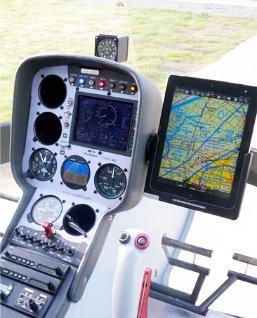
Another accessory now available for the Cabri is a fold-away and rotatable iPad holder/charger.
Bill has more than 4000 R22 hours on venison work alone and still accounts for well over 1000 deer in the Canterbury region annually. It’s only very recently that Bill had his first fly of a Cabri G2.
Reluctant to admit to Terry and Rob just how good he thought it was (it being more fun to say otherwise), he did tell us that he went out with Rob to the ‘Waimak’ a few weeks ago and “I gave it death. I actually made myself feel airsick. I flew it like a Hughes 500 and it can certainly do the business. We really threw it around and did corkscrews and some very high speed quick-stops – the governor works great. It does everything a Hughes 500 turbine helicopter does, just point it where you want to go.”
Bill also says he was very impressed with the low rotor rpm performance (rpm in yellow, pull collective, and climb). He says the only downside he can see is the purchase cost, but that aside, the Cabri will “spell the end of the R22”, and… he just might think about buying one.
Opinion – The Instructor
Rob Hunt is the Chief Flying Instructor for Pacific Helicopter Training. He comes from a teaching background and says that after “always telling students to follow their dreams”, he thought one day that he should follow his own advice.
He started training in 2009 at Nelson Aviation College, then taught there for 12 months. Following a couple of years of commercial work, he now has 1200 hours in his logbook with ratings on AS350, H500, R22, R44 and of course the Cabri G2. Rob joined Pacific Helicopter Training 6 months ago.
Rob says that after acclimatizing to the Cabri’s Fenestron tail and tight (new when he first flew it) controls, he really enjoyed it from his second flight on. He has since done a lot of mustering in the Cabri for one of the new owners and says its maneuverability and the sense of safety it imparts is outstanding.
He admits that pre-VAP installation, it could be tiring after 5-6 hours, but is like a different helicopter now and that he could sit in it all day long with ease. He also says it’s great to have so much room in the cabin when instructing with larger people.
The safety benefits (stability, forgiveness, margins, fenestron, crashworthiness, etc.) really come through when instructing too, says Rob; “Students can learn the basics to fly quite easily and then have a much greater safety margin available to them.”
“It means they can enjoy learning a lot more and it also provides us with more time to cater their training to specific needs if they have them, such as mustering.” Rob has been up in some ferocious NW winds when the mountain forecast was 35-40kts.
He was very impressed, saying that “the Cabri seemed to simply absorb the wind”. He also says it is exciting to be involved with something new and revolutionary. We can see his point. It’s quite enjoyable just to be able to fly a Cabri once in a while and write articles such as this about it.
Opinion – Ours
It shouldn’t be hard to tell from our previous flight test in KiwiFlyer, or these pages, that we think the Cabri is pretty special. If you’re a potential owner and wondering whether the features do justify the price then all we can do is to encourage you to find out more and go for a fly in one. We’ll be surprised if you’re not impressed too.
Frontier Helicopters’ new Cabri G2
Training, Lifting, Hunting, and much more…
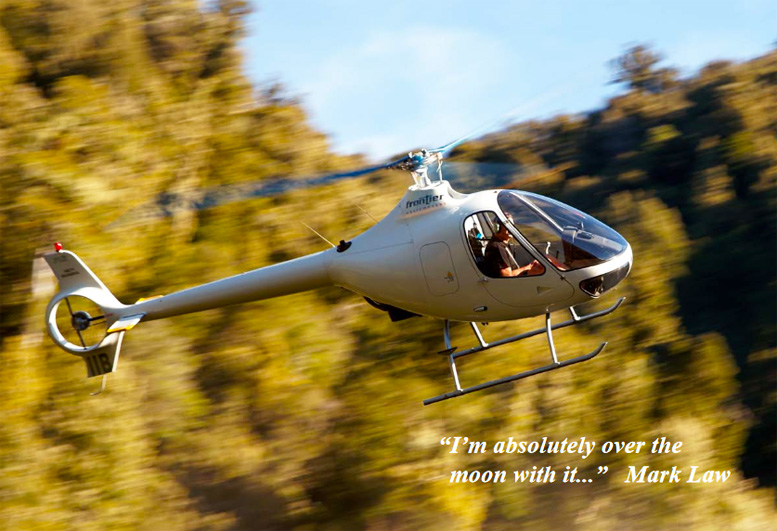
Mark Law enjoying his new Guimbal Cabri G2 in Te Urewera National Park, 20 minutes flying time from Frontier Helicopters’ base at Whakatane.
COURTESY: KiwiFlyer Magazine
Magazine of the New Zealand Aviation Community
SOURCE: Issue 29
SUBSCRIBE: http://www.kiwiflyer.co.nz/
CREDITS: Michael Norton – Editor | Publisher KiwiFlyer Magazine
BASED at Whakatane, Frontier Helicopters are the first company (aside from Distributors Pacific Aircraft) to operate a Guimbal Cabri G2 commercially in New Zealand. Established in 1998 (then as Bushland Helicopters) by Mark and Anna Law, the company has grown from solely a commercial deer recovery operation, to now providing flight training, other aerial work, and air transport.
Previously operating two Robinson R44s and an R22 (the Cabri replaces the R22), Mark flew just 0.6 hours in the demonstrator Cabri at Christchurch before being “sold on the aircraft and ordering one on the spot”.
Obviously Mark had done some homework first, but says he could see so many advantages to the aircraft that the decision was an easy one to make. That was before the new Vibration Absorbing Pendulums had been installed, Mark saying that the rest of the benefits he saw far outweighed the 85kt vibration niggle.
With VAPs fitted, the aircraft is even better and already Frontier Helicopters are putting a strategy in place that will see them acquire another one.
Frontier Helicopters History
Mark says his original purpose for the company was to shoot deer commercially. He bought an R22 and shot until 2003 when the market slowed.
He’s shot (and captured) deer all over New Zealand, developing an international reputation in the process which saw him spend three seasons capturing wild animals in the USA. This was mostly across the Central Western US, including forays into Mexico and Canada.
He says they captured almost every kind of big game animal in the States, mostly on behalf of Parks Departments. Some of the work was for the purpose of relocating animals and some was for population surveys and disease studies. They would often capture, then sample blood, saliva, hair, etc. either in the field or after slinging the animal back to a staging area.
Mark has also undertaken contracts to capture wild game in Kenya. After completing an Instructor Rating, Mark spent a year in Wanaka shooting and flight training, then it was back to Whakatane where he saw the opportunity to set up business.
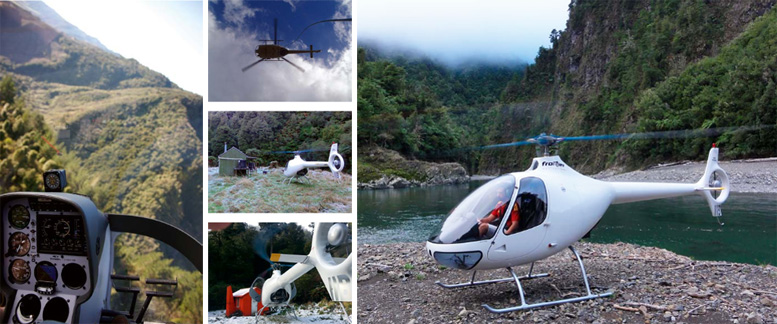
Note the (standard equipment) glass display in the bottom photograph, the excellent visibility past your feet, and also the adjustable pedals (the top bar rotates forward if required).
In 2009 Mark and Anna bought another local helicopter company and added Part 135 Air Transport Op’s into their business, operating to White Island, plus DOC work, charters, and flight training. Mark says that Frontier currently undertakes “everything but agriculure work”.
Frontier originally provided flight training in an R22, but wanted to “move ahead in regard to the overhaul regime and two bladed systems”, changing to a S-300 CBi. After 1400 hours in the CBi, it was sold to fund an R44 for White Island scenic trips and they returned to using a (leased) R22 for flight training.
When the Cabri came on to the scene, Mark saw it as an opportunity to again replace the R22, this time with a modern design and as an“investment in the future”.
Choosing a Cabri
Mark says there were plenty of reasons to make the Cabri an attractive proposition.
When he first flew the aircraft he says; “I became excited about flying a light helicopter again. I was so impressed with its robustness and ‘point and shoot’ flying. There was no lag in turns and it felt just like a small ‘500’. It imparts a sense of trust in turbulence and put a real spark back in my flying”.
“It’s very responsive and nothing feels flimsy or bendy. The only thing that took some getting used to was the pedal movements – you need to lead with pedal for the best result. The vibration has been completely addressed. The only thing you can feel now is the engine”.
Particularly in regard to flight training, Mark considers he has a lot of responsibility as an Instructor, and owner, to be doing everything as right as he possibly can, such that if the student does make a mistake, they could still safely get on the ground.
There’s plenty of interesting places to fly and confined areas to land in when Te Urewera National Park is on your back doorstep. Flying time from Whakatane to the Ureweras is little more than 20 minutes.
Frontier Helicopters operate commercially in the park with DOC concessions, where the Cabri’s very low noise signature (thanks to the Fenestron tail and upwards pointing exhaust) is ideal for ‘flying friendly’.
He says the Cabri offered so many safety improvements that he saw the advantage straight away. Subsequently he (and other Instructors) feels much better when sending students out on their first solo. The Cabri is the first helicopter to carry EASA (European Aviation Safety Agency) certification.
Seats for example are designed such that a 2000 fpm vertical impact is deemed to be survivable, and the fuel bladder has been designed to F1 safety standards. Mark also emphasizes the benefit of training with a glass cockpit and the technology that is built into the Cabri; “it’s all great for students and is the way of the future”.
Another benefit when operating in the coastal environment of Whakatane is the composite fuselage, which is of course immune to corrosion. And Mark says also liked the concept of having nearly all components running on-condition, without the requirement of a big budget overhaul every 2200 hours / 12 years.
Frontier’s Cabri helicopter went on line at the start of April and already has 300 hours on the hobbs. Mark expects to put at least 800 hours on the aircraft in its first year of operation. A lot of commercial work has been done with it already. Since the hook was fitted, about 40 hours of long-lining have been logged.
The hook is capable of lifting 220kg and according to Mark was easy to install and functions well. They also have a grappel and a small fire bucket for training purposes. TV watchers may have seen Frontier’s Cabri on Campbell Live a few weeks ago when they completed a contract to shoot swans over the Manukau Harbour at Auckland Airport.
800 were accounted for in a short space of time. That video is available online, as are several others including deer recovery and mountain flying in the Cabri helicopter. See them at: www.frontierhelicopters.co.nz
Training at Frontier Helicopters
Frontier presently have two CPL students training on the Cabri, with four more scheduled to start in November. Both are enjoying the experience of training in a commercial environment with experienced Instructors. Mark himself has 3000 hours of instructing time now and also undertakes check rides for one of the major tuna boat helicopter operators.
Mark says that the Cabri is allowing their students to focus on doing well rather than simply staying in control – and allows them to move to advanced training much more quickly. An example is the amount of sling work that Frontier incorporates into the 150 hour commercial syllabus. Commercial students complete 20-30 hours of long-lining.
Mark explains; “We start on 100 feet which gets great results as students soon learn patience in a high hover. Then we go up to 150 feet and then all the way back down to 5 feet. Then we work with 200-250 feet long-lines to finish off. Grapple training is usually on 100 feet lines and for the bucket we use 50”.
After the long-line training, students complete the night flying syllabus. Type ratings then follow for the R44 and MD369 series including NOTAR. A lot of low level flying training is conducted, especially including safe techniques and low level autorotations.
Mark says that all their students end up in work, in large part because all of them are motivated by having spent their own money to train rather than the taxpayers. Frontier always take on their own students for the company’s Part 135 operations.
Frontier’s training environment is integrated into a strict commercial regime. Students live the working lifestyle and all pilots and students are expected at the hangar before dawn, ready for lift off at first light. As Mark says, it’s the best time for flying.
In fact the night syllabus training is often conducted in the early morning. PPL students are frequently flying 3 hours a day which Mark says creates great continuity with their training and provides for very efficient and fast learning.
Frontier are working on obtaining Part 141 certification and are then intending to start marketing their flight training services. Presently, all their students arrive by word of mouth references.
Future Plans at Frontier
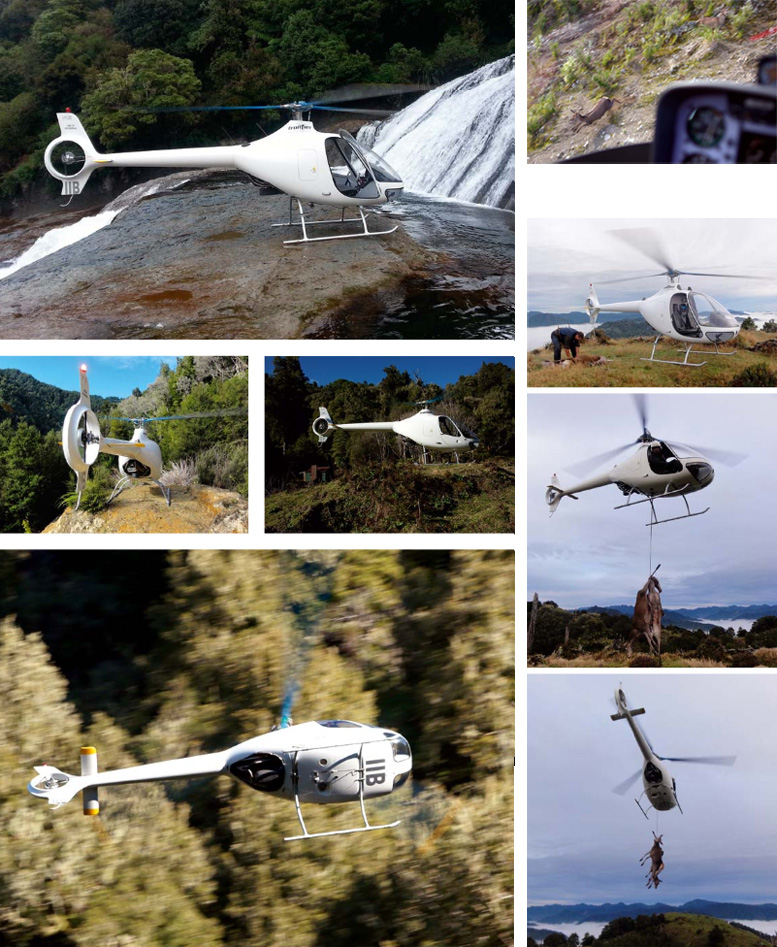
Mark Law pilots the Cabri in pursuit of wild Urewera deer. This is the first Cabri to be put to work on deer recovery. Frontier will also use it with a grapple to long-line logs and with a small fire bucket for training.
Frontier Helicopters are well underway with various opportunities that will lead to expansion of the business. One of these is for a heliport and White Island Visitor Center to be based in Whakatane township. Mark says that the concept has been well received so far with several key players considering it to be good for the district.
They are currently exploring the idea of providing NVG training in the Cabri and in regards to aircraft, the R44s may well soon turn into an AS350. Mark says their plans are about operating as a niche player where it’s “easier to differentiate the business and charge the rates needed to maintain good gear and a safe operation”.
KiwiFlyer wishes them every success.
For more information
To find out more about Frontier Helicopters and the services they offer, visit their website which is regularly updated and includes several video clips of company operations. Phone 0800 804 354 Email: info@frontierhelicopters.co.nzwww.frontierhelicopters.co.nz
Training in the Cabri G2 with Frontier Helicopters
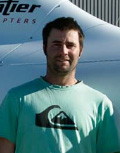
Chris Easton
Chris Easton: Chris says he was always into hunting and fishing and grew up around helicopters and deer recovery. With his sights on flying commercially he saved money by working in Australian mines as he didn’t want to borrow. He came to Frontier on the recommendation of other pilots and was nearly solo in an R22 when the Cabri arrived.
He says it was tricky to adjust to the clockwise rotor system and there were plenty of good laughs for bystanders. However the Cabri is “a lot more stable, roomy, and nicer to fly”. Chris self studied for his PPL and is off to Nelson Aviation College soon to complete their CPL theory block course so he can concentrate on the rest of his CPL flying.
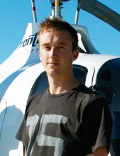
Sam Stewart
Sam Stewart: Sam started flying after high school, completing a fixed wing PPL in Taupo but decided he wanted something more exciting. Frontier were recommended by family members and within a month he completed his PPL(H). Sam lives in Havelock and stays at Frontier for a week at a time, in the flat above their hangar.
He typically flies 15 hours a week over 5 or 6 days and with 145 now in his logbook, is completing final revision for his flight test. Sam has flown S-300s as well as the Cabri and R22. He has also just completed a NOTAR rating but says out of all those types, the Cabri is the easiest to fly, feeling safe and stable and needing little effort to fly well.
He has often flown between Havelock and Whakatane in poor weather and needed to divert to the coast, saying he has felt much more comfortable in the Cabri when conditions deteriorated. Sam says that using ‘lots’ more pedal than in the 22 took a little time to get used to and reading the glass screen instead of traditional instruments was also a learning curve.
He notes how good visibility from the Cabri cockpit is with no center bar in the screen and the view available beneath your feet, and also says the luggage capability is great.Sam says that the environment at Frontier is relaxed but very professional.
There’s no time wasted at Whakatane airfield because it’s always quiet there, but controlled airspace is only 25 minutes away and the hills are only 20. Low flying and sling practice areas are very close.
He says it’s great to be able to absorb teachings from Mark’s commercial experience and to be able to participate in commercial operations at the company. He says that Mark is easy to learn from, being relaxed and informative, “letting you learn without feeling pressured and keeping training moving along too”.
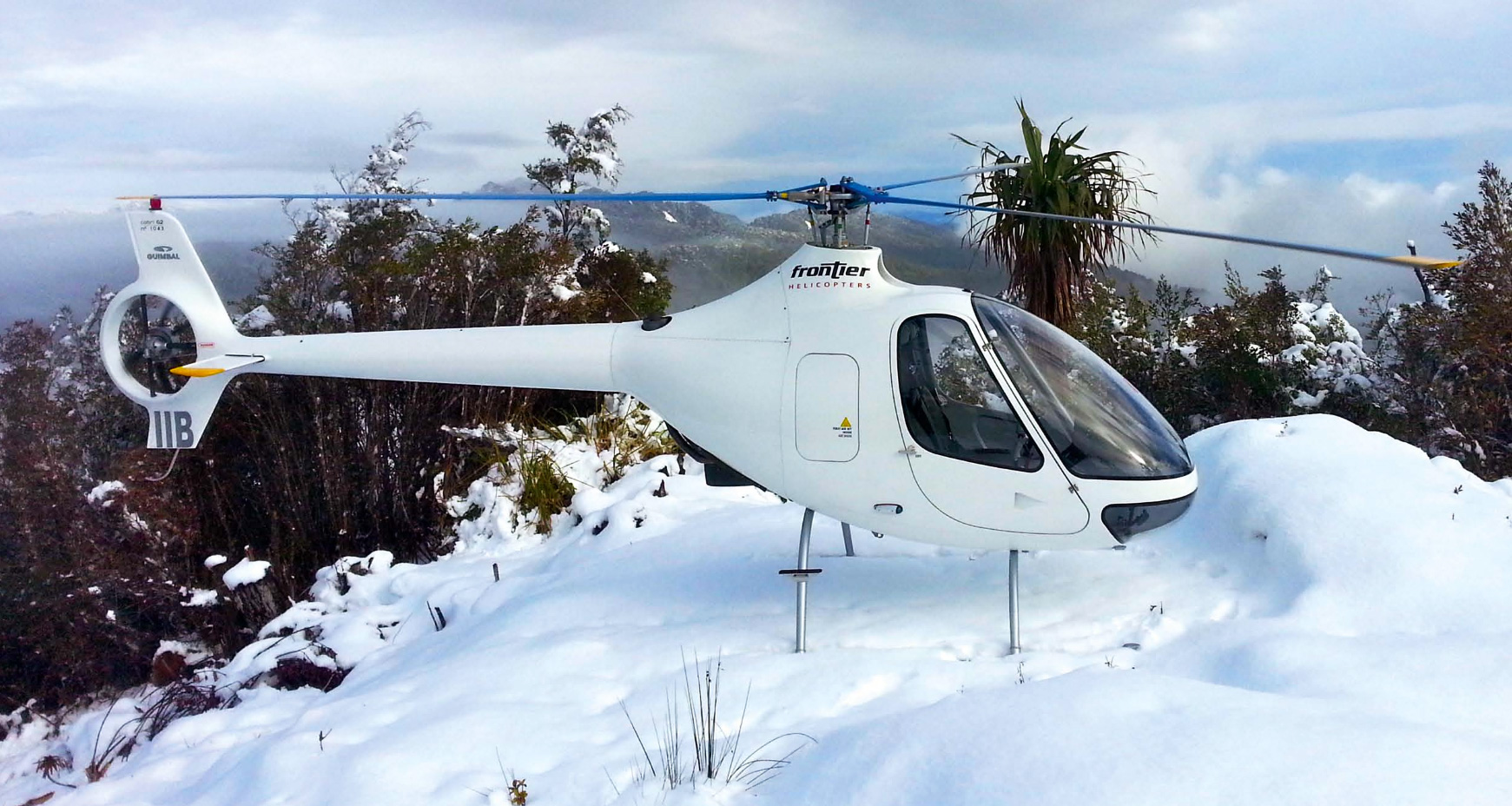
Frontier Helicopters’ new Guimbal Cabri G2 on a winter’s day. Photo: Frontier Helicopters.






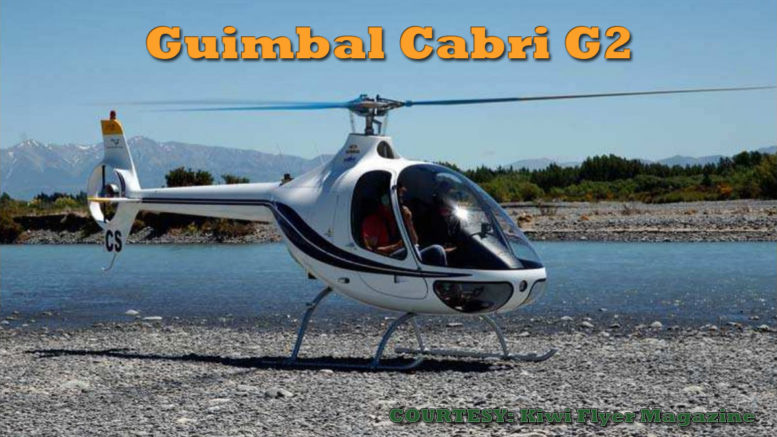
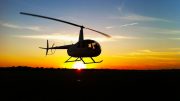
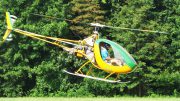
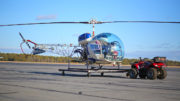
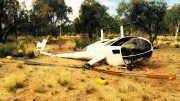
Be the first to comment on "Guimbal Cabri G2 – Flight Test"